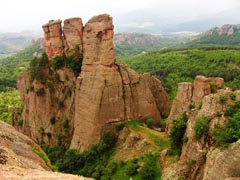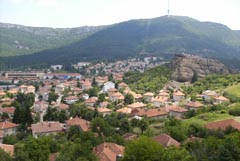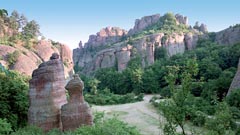Vote for Belogradchik Rocks
Why elect the New 7 Wonders of Nature?
The campaign to choose The Official New7Wonders of the World was a resounding success, in which more than 100 million votes were cast and which took democracy to a new, global level. We know that the New7Wonders of Nature campaign will significantly raise awareness of the incredible variety and beauty of nature around us. As our slogan says, “If we want to save anything, we first need to truly appreciate it!” This is something that is very important - more awareness and more tourism income means that these natural treasures can be better preserved for future generations.
What is the criteria necessary for the participation and for the 21 finalists?
Candidates in the Official New7Wonders of Nature campaign are clearly defined natural sites that have neither been created by nor significantly altered by humans for aesthetic reasons.
The 21 Official Finalists will be chosen by the New7Wonders Panel of Experts under the leadership of Prof. Dr. Federico Mayor, former Director-General of UNESCO.
The selection of the Finalists will be made from the Top 77 New7Wonders of Nature nominees on July 7, 2009 - as determined by votes cast by the world’s population.
Following the established and recognized process used for the man-made Official New 7 Wonders of the World campaign, the N7W Panel of Experts will anonymously choose the 21 Official Finalists using their vast experience and their personal judgment, bearing in mind the following general criteria:
1. Unique beauty of the nominated site;
2. Diversity and distribution (accounted for in 7 groups);
3. Ecological significance (in terms of either stand-alone eco-systems and/or their significance for human beings);
4. Historical legacy (relation that human beings and/or indigenous populations have or have had with the site);
5. Geo-location (even distribution of the 21 Official Finalists between all continents).
The 21 Official New7Wonders of Nature Finalists will be announced on July 21, 2009.
When will the New7Wonders of Nature be declared? What are the stages of the election?
There are three stages in the New7Wonders of Nature campaign: the National Qualification, the Nomination stage and the Finalist stage:
On 1 January 2009, only one national nominee per country will be allowed to proceed: the highest ranked in the voting on 31 December 2008. Therefore until the end of 2008, countries with more than one nominee will be racing to choose the national representative that is allowed to continue into 2009. Nominees shared by more than one country will remain and continue into 2009.
In the Nomination stage, voting for nominees will continue through July 7, 2009. Then the New7Wonders of Nature Panel of Experts, under the leadership of Prof. Federico Mayor, former Director-General of UNESCO, will review the top 77 nominees and choose the 21 finalists, to be announced on 21 July 2009.
For the Finalist stage, the 21 New7Wonders of Nature Finalists will be put to popular vote in July 2009. Voting will continue throughout 2010 and into 2011. During this time, the New7Wonders World Tour will visit each of the Finalists to allow them to present themselves to the voters across the globe.
The final declaration of the New7Wonders of Nature will be in 2011.
Can there be more than one Finalist and more than one of the New7Wonders of Nature from the same country?
No, there will only be one Finalist per country, except for Finalists that share countries, for example those that cross national borders.
How many times can I vote?
Via www.new7wonders.com you can only vote once in each stage (nominee/Top 77 stage and Finalist stage), identifying yourself using your email address.
Please note that each person must vote for 7 different natural sites when they vote in each of the two stages.
Why does a nominee need an Official Supporting Committee (OSC)?
Without an Official Supporting Committee (OSC), a nominee cannot be considered for selection as one of the 21 Finalists. The Finalists will be chosen out of the Top 77 Official Supported Nominees in July 2009 by the New7Wonders Panel of Experts. Visit the OSC page to find out more.
Will it be possible to vote for the New7Wonders of Nature by SMS and via phone?
Yes, SMS and phone voting will be phased in for the Finalist stage after 21 July, 2009.
History of Belogradchik
Belogradchik was first established as a village at the time of the Romans, who built a Fortress whose relic remains today. The town was repeatedly destroyed and rebuilt through history. There are records of the town’s existence dating to the Turkish Register of 1454. In 1850, there was a local insurgent rebellion which was crushed by the Turks. After the 1878 Liberation, the Fortress was restored to its present form and is now a major tourist destination.
The Rocks
The Belogradchik rocks - this rock tale - lay (from the West to the East) from Vedernik, near the town of Belogradchik, the village of Borovitsa, to the village of Belotintsi. The area length is about 30 km and its width is 3 km. Many of the rocks are related with interest legends. The central group of rocks is situated to the South of Belogradchik. Here are the most interesting and impressive formations - Adam and Eve, The Schoolgirl, The Bear, The Shepherd boy, The Dervish, The First slabstone, The Camel, The Mushrooms, The Cuckoo, The Red wall, The Madonna, The Horseman, The Monks, The Mental stone, Rebel Velko, The Pine stone and many others. They are declared as a natural landmarks. The second group is to the West of the town. The rocks are of Alpine type, they surround big precipices. The most famous rocks are Zbegovete, Erqupriya, Boritch. The third group is some 4 km away to the East of the town, which includes the rocks around The Latin Kale and The Lipenik cave. The fourth group is extended between the villages of Borovitsa and Falkovets. There are the well-known Pine stone (declared as a natural landmark), The Red stone, The Bee stone, Torlak, The Maid’s rock The last group is situated between the villages of Gyurgitch and Belotintsi. Sand-mergel rocks have been stratified in this region about 200 million years ago (in the end of the palaeozoic period). Later they have been overflowed by a sea, on the bottom of which sand, gravel and clay, dragged up by the rivers, have been piled. In the course of time these materials have been fitted together by silicon or sand-clay solder. Conglomerates and sand-stones, known as colored sand-stone - boundsandstein, have been formed in this way. Under the influence of the iron oxide they have gotten a red shade. Gray and cream-white limestone have been piled up the sand-stones during the Jurassic period. They formed the foreheads of the present Belogradchik’s Venets and Vedernik. During the folding of The Balkan Mountains this region turned to dry land. Rifts have appeared in its highest part, under the destroyed function of water, winds and the temperature variations. This action have reached the sand-stones. Because of their different hardness they have been destroyed unequably. So the fantastic outlines of the Belogradchik rocks have been created during million years. Over 100 caves - rich in beautiful formations, precipices and interesting fauna have been formed in the sand-stone and the limestone . The most famous - The Magura cave (its length is over 2500 m) is well laid out - lighting, safeguard fittings. With the surrounded area it is declared as a natural landmark.



You have
one voice and seven votes:
www.new7wonders.com
belogradchik-bg.net
LIVE RANKING: 18-FEB-2009
GROUP D
1. Belogradchik Rocks Bulgaria
2. Diavolja Varos Serbia
3. Grand Canyon USA
4. Rock of Aphrodite Greece
5. Avers Rock (Uluru)
6. Jeita Grotto
7. Colca Canyon
8. Crystal Caves
9. Rock of Gibraltar
10. Pravcice Gate